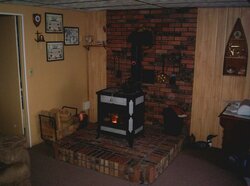hay guys i am installing a avalon free standing wood stove i was wondering what is the clearance for single wall pipe for a none combustible wall the stove is being installed in front of a brick wall witch is in front of a combustible wall with a 1-1/2 inch air space
the single wall will go straight up to a double wall pipe. the picture is not mine but the brick is just like how mine is and how my stove will be install except mine will go straight up through the attic and my brick wall is 1-1/2 inches away from the main wall
thanks
Jason
the single wall will go straight up to a double wall pipe. the picture is not mine but the brick is just like how mine is and how my stove will be install except mine will go straight up through the attic and my brick wall is 1-1/2 inches away from the main wall
thanks
Jason



